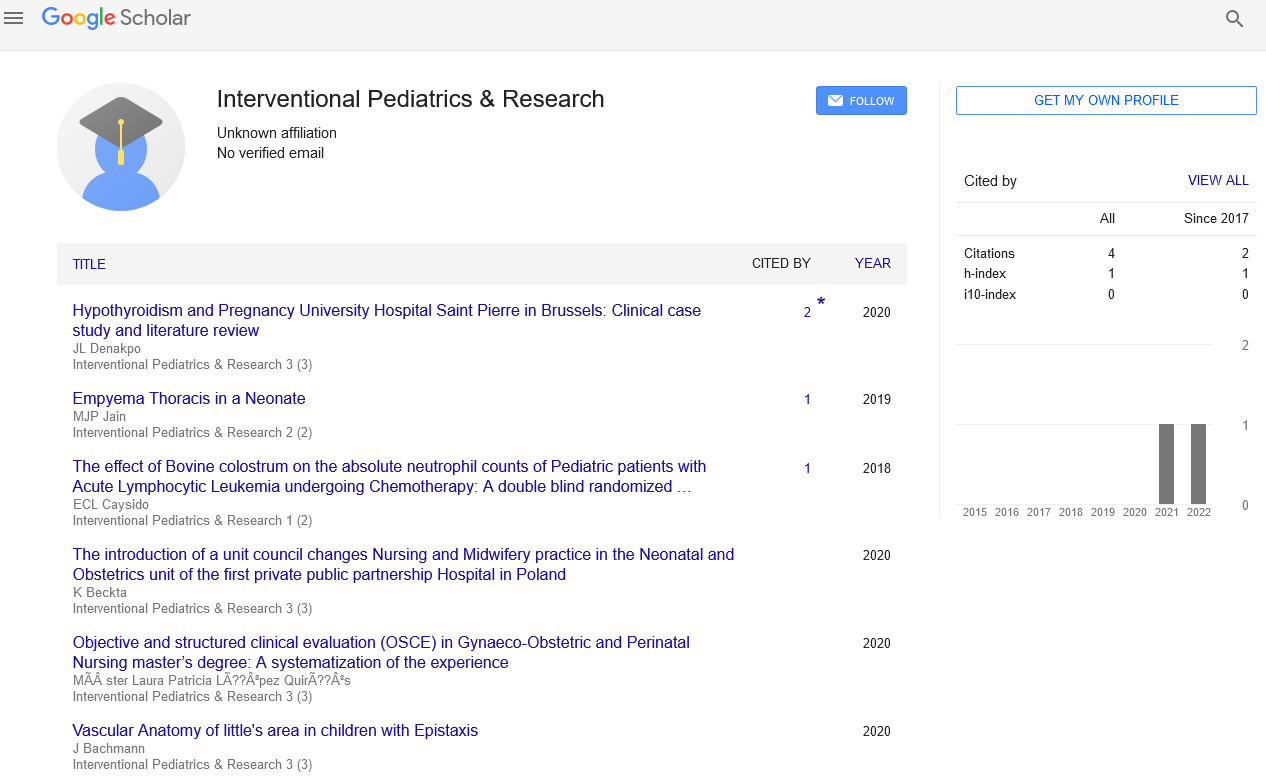Mini Review - Interventional Pediatrics & Research (2023) Volume 6, Issue 1
A novel diagnostic tool for identifying patients with inflammatory and/or virally induced cardiomyopathies is microRNA profiling.
Peter Abbey*
Deparment of Interventional Pediatrics Ethiopia
Deparment of Interventional Pediatrics Ethiopia
E-mail: abbey_p7@gmail.com
Received: 30-Jan-2023, Manuscript No. ipdr-23-88257; Editor assigned: 01-Feb-2023, Pre-QC No. ipdr-23- 88257(PQ); Reviewed: 15-Feb-2023, QC No. ipdr-23-88257; Revised: 17- Feb-2023, Manuscript No. ipdr-23- 88257(R); Published: 24-Feb-2023, DOI: 10.37532/ipdr.2023.6(1).01-03
Abstract
For the purpose of determining whether an inflammatory or viral process is to blame for undiagnosed heart failure, microRNAs (miRNAs) could be used as potential biomarkers. Prognostic miRNAs in the serum of patients with inflammatory heart diseases discovered through end myocardial biopsies were the focus of this study The identification of patients with intramyocardial inflammation and/or viral persistence solely from a single serum sample, independent of prescribed therapy and the time of onset of symptoms, is made possible for the first time by this miRNA profile, which offers a novel non-invasive diagnostic perspective. It makes it possible to identify patients who are suitable for myocardial biopsy early on, allowing for a precise diagnosis and subsequent prescription of specific treatment based on causal aetiology
Keywords
MiRNA • Virus • Inflammation • Myocarditis • DCM
Introduction
As a prerequisite for an aetiology-driven treatment, end myocardial biopsies (EMBs) are the gold standard for determining the causes of unexplained heart failure (HF). Despite this, EMB is rarely utilized due to the absence of clear, non-invasive diagnostic criteria [1]. Post-transcriptionally regulating mRNA expression, microRNAs (miRNAs) are non-coding RNAs that bind to complementary sequences on the translated region of target messenger RNAs (mRNAs). It is already known that miRNAs play a role in myocardial injury and inflammation as well as in cardiac differentiation, 8 proliferation, and apoptosis [2]. The miRNA profile has emerged as a potential biomarker for many human diseases, particularly cardiovascular diseases, providing novel molecular insights and new therapeutic approaches to disease treatment due to their stability in the circulatory system. Dilated cardiomyopathy (DCM) has been linked to cardio enriched miRNAs, which have been linked to cardiac development [3]. The lack of large cohort studies on miRNA normalization, drug interactions, and quality reporting of statistical multivariable analysis of the observational studies on miRNAs are a few of the main reasons why miRNAs have not yet entered the clinical routine. In addition to being a biomarker of disease course and survival, several data suggest that miRNA profiling in serum samples may be a diagnostic marker for specific inflammatory heart disease [4]. As a result, the miRNA expression levels of biopsyproven patients with DCM and viral/inflammatory myocardial diseases were compared to healthy controls in this retrospective study that was intended to determine differential miRNA patterns in human serum samples [5]. In order to select patients who require EMBs as a prerequisite for precise diagnosis and causally specific treatment, the purpose of the study was to identify novel clinically relevant diagnostic markers of HF in the form of miRNAs [6].
Methods
Analyses from end myocardial biopsy
Evaluation of inflammation through histological and Immunohistochemical staining We made the following diagnoses for patients using EMB: Histological evidence of inflammatory infiltrates of >14.0 lymphocytes/ mm2, including >7.0 CD3+ lymphocytes/ mm2, within the myocardium associated with myocyte degeneration and necrosis was used to diagnose an active myocarditis based on the Dallas criteria 20.Histological evidence of inflammatory infiltrates within the myocardium without myocyte degeneration or necrosis was used to diagnose a borderline myocarditis [7]. Evidence of an association between dysfunction in the heart and inflammation in the intramyocardial was used to diagnose inflammatory cardiomyopathy (DCMi). A dilated or significantly impaired left ventricular ejection fraction and/or morphological and functional characterization led to the diagnosis of DCM. EMBs from DCM patients were negative for cardio tropic viral genomes and histologically or immunohistologically detected inflammation. Due to a lack of data, the study did not include any patients who had a genetic form of cardiomyopathy [8]. EMB evaluation, used antibodies, and the immunohistologically staining procedure can all be found elsewhere.
TaqMan Open Array and qRT–PCR are utilized for the reverse transcription, pre-amplification, and expression of microRNAs.
Initially, the TaqMan MicroRNA Reverse Transcription Kit for low-content samples and the Megaplex stem-loop RT primer for Human Pool A and B were used to reverse transcribe total RNA, including the miRNA fraction, to cDNA. The entire method for measuring miRNAs is explained elsewhere. 25 The reference miRNA for data normalization was HsamiR30a-3p.
Other microRNAs and cardiovascular disease research
However, up to this point, every investigation has been carried out at the research level. As a potential biomarker for myocardial injury, MiR- 208 production was only found in the heart. After isoproterenol-induced myocardial injury, plasma concentrations of miR-208 significantly increased (P 0.0001) and followed a time course similar to that of cTnI, a well-known biomarker of myocardial injury[9]. Haematopoietic lineage differentiation, immunity, inflammation, viral infections, and vascular remodelling are all influenced by microRNA 155, which is linked to cardiovascular diseases like coronary artery disease (CAD), heart failure, and diabetes mellitus. 33 However, the outcomes are inconsistent. Patients with heart failure have decreased levels of circulating miRNAs such as miR18a, miR27a, miR30e, miR26b, miR199a, miR106a, and miR652. Within 48 hours of admission for acute heart failure, decreases in the circulating miRNAs let7i, miR18b, miR18a, miR223, miR301a, miR652, and miR423 have been reported, and they are associated with an increased risk of 180 days of mortality [10].
Discussion
We were able to distinguish between patients with DCM, inflammatory, or virally induced cardiomyopathies and healthy controls with a specificity of 95% based on the expression of let7f, miR197, miR223, miR93, and miR379, and between patients with a virus or/ and inflammation and healthy donors with an average specificity of 93%. Taking EMB from patients with suspected inflammation or viral heart muscle disease to identify causative factors and obtain a clear diagnosis and biopsy-proven causal treatment is clearly indicated by this novel approach, which has high clinical relevance. The main takeaway from this study is that taking EMBs, the gold standard for accurate diagnosis, requires precise molecular signatures in the serum to improve clinical detection of patients with inflammatory or viral diseases. In this study, we demonstrated that EF, gender, and age have no significant impact on the expression level of miRNAs in this context. As a result, the miRNA profile can identify patients with inflammatory or virally induced cardiomyopathies based on the expression level of specific miRNAs regardless of other factors.
References
- Escher F, Tschöpe C, Lassner D et al. Myocarditis and inflammatory cardiomyopathy: from diagnosis to treatment. Turk Kardiyol Dern Ars. 43, 739–748 (2015).
- Ling H, Fabbri M, Calin GA. MicroRNAs and other non‐coding RNAs as targets for anticancer drug development. Nat Rev Drug Discov. 12, 847–865 (2013).
- Hodgkinson CP, Kang MH, Dal‐Pra S et al. MicroRNAs and cardiac regeneration. Circ Res. 116, 1700–1711 (2015).
- Wang E, Nie Y, Zhao Q et al. Circulating miRNAs reflect early myocardial injury and recovery after heart transplantation. J Cardiothorac Surg. 8, 165 (2013).
- Yang L, Wang B, Zhou Q et al. MicroRNA‐21 prevents excessive inflammation and cardiac dysfunction after myocardial infarction through targeting KBTBD7. Cell Death Dis. 9, 769 (2018).
- Schulte C, Zeller T. microRNA‐based diagnostics and therapy in cardiovascular disease—summing up the facts. Cardiovasc Diagn Ther. 5, 17–36 (2015).
- Dimmeler S, Zeiher AM. Circulating microRNAs: novel biomarkers for cardiovascular diseases. Eur Heart J. 31, 2705–2707 (2010).
- Condorelli G, Latronico MVG, Cavarretta E. microRNAs in cardiovascular diseases: current knowledge and the road ahead. J Am Coll Cardiol. 63, 2177–2187 (2014).
- Schultheiss HP, Fairweather D, Caforio ALP. Dilated cardiomyopathy. Nat Rev Dis Primers. 5, 32 (2019).
- Condrat CE, Thompson DC, Barbu MG. miRNAs as biomarkers in disease: latest findings regarding their role in diagnosis and prognosis. Cell. 9, 276 (2020).
Indexed at, Google Scholar, Crossref
Indexed at, Google Scholar, Crossref
Indexed at, Google Scholar, Crossref
Indexed at, Google Scholar, Crossref
Indexed at, Google Scholar, Crossref
Indexed at, Google Scholar, Crossref
Indexed at, Google Scholar, Crossref
Indexed at, Google Scholar, Crossref
Indexed at, Google Scholar, Crossref


